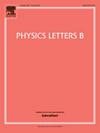建议使用大型强子对撞机通用探测器对长寿命粒子进行“束流转储”测量
IF 4.3
2区 物理与天体物理
Q1 ASTRONOMY & ASTROPHYSICS
引用次数: 0
摘要
我们提出了一种在大型强子对撞机上使用通用探测器(ATLAS和CMS)进行类似束流转储实验的新方案。高能质子的碰撞会产生包含大量高能强子和电磁物体的射流,这些物体本质上分别被“倾倒”到强子和电磁量热计中,并在量热阵雨中诱导次生强子、电子和光子的产生。我们设想一种新的物理粒子是由这些次级粒子在量热计内的相互作用产生的。为了证明原理,我们考虑了通过Primakoff过程产生的类轴子粒子(ALPs),它们在CMS中与光子相互作用。我们认为,漂移管腔和μ子系统的ME0模块可以作为探测器来记录来自ALP衰变的光子,这表明,假设本工作中讨论的背景电平可以控制,由于它们靠近信号源点,由此产生的灵敏度达到具有竞争力。我们进一步表明,大型强子对撞机不受束流转储“天花板”障碍的影响,这是典型的束流转储实验很难超越的。这使得大型强子对撞机有很大的潜力去探索更大范围的参数空间。这种分析可以扩展到研究与标准模型轻子和夸克耦合的各种类型的光介质。本文章由计算机程序翻译,如有差异,请以英文原文为准。
Proposal to use LHC general-purpose detectors in “beam-dump” measurements for long-lived particles
We propose a novel scheme for performing a beam-dump-like experiment with the general-purpose detectors (ATLAS and CMS) at the LHC. Collisions of high-energy protons result in jets containing a number of energetic hadrons and electromagnetic objects that are essentially “dumped” to hadronic and electromagnetic calorimeters, respectively, and induce the production of secondary hadrons, electrons, and photons in calorimetric showers. We envision a situation where new physics particles are produced by the interactions of these secondary particles inside the calorimeters. For proof of principles, we consider the axion-like particles (ALPs) produced via the Primakoff process in the presence of their interaction with photons at CMS. We argue that the drift tube chambers and the ME0 module of the muon system can serve as detectors to record the photons from the ALP decay, demonstrating that assuming the background level can be controlled as discussed in this work, the resulting sensitivity reach is competitive due to their close proximity to the signal source points. We further show that the LHC does not suffer from a barrier, dubbed beam-dump “ceiling”, that typical beam-dump experiments hardly surpass. This gives the LHC great potential to explore a wide range of parameter space. This analysis can be extended to investigate various types of light mediators with couplings to the Standard Model leptons and quarks.
求助全文
通过发布文献求助,成功后即可免费获取论文全文。
去求助
来源期刊

Physics Letters B
物理-物理:综合
CiteScore
9.10
自引率
6.80%
发文量
647
审稿时长
3 months
期刊介绍:
Physics Letters B ensures the rapid publication of important new results in particle physics, nuclear physics and cosmology. Specialized editors are responsible for contributions in experimental nuclear physics, theoretical nuclear physics, experimental high-energy physics, theoretical high-energy physics, and astrophysics.
 求助内容:
求助内容: 应助结果提醒方式:
应助结果提醒方式:


